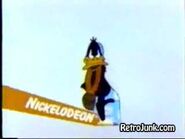|
Stamped on June 2017. This article or section needs additional citations for verification. Please add reliable citations to help verify the article's content.
Do not use Wikipedia or any other wikis as a source. Unsourced info can be questioned and may be removed without notice. Do not remove this template until all conditions have been met. |

Current logo since March 4th, 2023
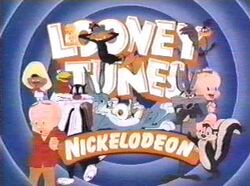
The Looney Tunes on Nickelodeon logo card, used from 1988 through 1992
Nickelodeon, originally called "C-3" from its launch on 1 December 1977 until 31 March 1979, often called "Nick" for short, is a 24-hour network dedicated to delivering programming geared toward children. The channel is currently owned by Paramount Domestic Media Networks. It was originally owned by Looney Tunes owner, Warner Bros. Nickelodeon is best known for its long-running show SpongeBob SquarePants. Nickelodeon also hosts sister channels which rerun Nick's older content.
Looney Broadcast History[]
Looney Tunes (1988-1999)[]
Nickelodeon began airing Looney Tunes on Nickelodeon on 12 September 1988.[1] Initially, Nickelodeon's selection of Looney Tunes was made mostly of black-and-white pre-1943 cartoons and cartoon shorts of the post-1960 time period, plus colorized versions of the Porky Pig cartoons from the 1930s and early 1940s. Nick did have access to some cartoons released between 1948 and 1960, though, and thus aired them very often.
Until 1993, each installment tended to feature three or four cartoons, of which the second, usually black-and-white, starred Bosko, Buddy, or Porky Pig. During the first few years of Looney Tunes on Nickelodeon, the opening sequence with the Warner Bros. logo and the closing "That's all, Folks!" cards were not included on the cartoons, but the opening credits to the cartoon shorts were shown. The ending frame of each cartoon was often shrunk into a ball which bounced into a picture of a group of characters standing in front of the Looney Tunes on Nickelodeon logo. The one exception to this was "Guided Muscle", in which, instead of the bouncing-ball ending, Wile E. Coyote dragged the Looney Tunes on Nickelodeon card across the screen at the end; originally, he dragged across the "That's All, Folks!" card. Each show would end with a single closing card. Unlike Cartoon Network or Boomerang, which are now owned by Time Warner, Nickelodeon did not have the rights to use the opening, ending, and the "That's All Folks!" titles on every short at the time.
In addition to the version that aired during the day and early evening on Nick, the channel also packaged a version of the Looney Tunes program for its Nick@Nite block. The opening to this version showed clips from the cartoons of characters preparing for, or in, bed. These installments were also a half-hour long, and also usually included a black-and-white cartoon.
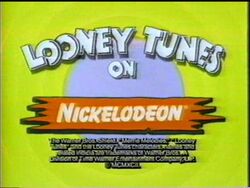
The second Looney Tunes on Nickelodeon logo, used from 1992 through 1999
In September 1992, some shuffling of cartoons between broadcasters allowed Nick access to an additional number of Looney Tunes shorts. A new theme song was made, and this time the cartoons were shown with their full openings and closings intact, much like Cartoon Network and Boomerang. Unlike Cartoon Network and Boomerang, sometimes thick colored borders were added to the original openings and closing titles of the cartoons.
The black-and-white cartoons were dropped from the shows; one promotional spot lampshaded this by stating that Nick now had "More Bugs, more Daffy, more Tweety, and no Bosko". While they dropped the show from Nick @ Nite, the redrawn colorized Porky Pig cartoons were replaced with new, computer-colorized versions from the 1990s, although Nick continued to air redrawn versions of "Porky's Midnight Matinee", "Rover's Rival", and "Slap Happy Pappy". For the whole 1994-95 season, Nick had the most variety of shorts in their Looney Tunes package; the following year, it dropped a small amount when The WB Network assumed possession of several cartoons for That's Warner Bros.! on Kids' WB!
From 1995 to the end of 1997, Nickelodeon's batch of cartoons remained constant. "Wet Hare", "Mad as a Mars Hare", and "D' Fightin' Ones", having been ABC staples since 1985, transferred to Nick in 1994. However, at the start of 1998, Nickelodeon and ABC swapped several cartoons. "The Fair Haired Hare" and "Hoppy Daze" were finally relinquished by ABC to air uncut on Nick, while ABC reacquired "Mad as a Mars Hare", "D' Fightin' Ones", "Rabbit Rampage", "Ali Baba Bunny", "Dr. Jerkyl's Hide", "What's Opera, Doc?", "Hare Brush", and more. A number of initially black-and-white Porky Pig cartoons commenced transmission on Nick in computer-colorized format in 1998.
In early 1999, it was announced that Nick's package of Warner Bros. cartoons would soon be relocating to Cartoon Network. The final installment of Looney Tunes on Nickelodeon ran on September 11, 1999, containing "The Cats Bah", "Porky in Wackyland", "The Daffy Duckaroo", "To Beep or Not to Beep", "Tree for Two", and "Of Rice and Hen".[2][3][4]
Censorship[]
- Main article: Looney Tunes on Nickelodeon Censorship
Looney Tunes on Nickelodeon, both the original daytime version and later Nick at Nite version, edited several cartoons for content when shown.
In contrast to network television of the time, much of the slapstick violence, scenes of alcohol and tobacco consumption, suggestive humor as seen with the Pepe Le Pew cartoons, and depictions of Mexican/Latino stereotypes as seen with the Speedy Gonzales cartoons that would normally be cut or banned elsewhere were left intact here. However, the channel did have their own criteria of what was objectionable for kid/family viewing and edited the following:
- Profanity as in "Bosko's Picture Show" and "I Was a Teenage Thumb";
- Dangerous, imitable behavior, especially in scenes where the activity is shown as harmless and/or the characters face no repercussions, such as:
- Lighting fireworks in "His Bitter Half"
- Mishandling electricity in "Dough Ray Me-ow" and "Lighthouse Mouse"
- Swallowing pills in "Beep, Beep", "Stop! Look! And Hasten!", "Hopalong Casualty", and "Mexican Boarders".
- Running into busy traffic in "Honey's Money", though "A Broken Leghorn" was shown uncut,
- Hanging from nooses in "Good Noose", "Big House Bunny", and "Skyscraper Caper"
- Ingesting dangerous chemicals in "Porky's Midnight Matinee", "Bye, Bye Bluebeard", and "Show Biz Bugs"
- Being locked in small spaces in "Corn Plastered" and "Good Noose"
- Scenes featuring outdated African, African-American, and East Asian stereotypes. American Indian stereotypes were either left in as with the channel airing "The Daffy Duckaroo", "Tom Tom Tomcat", and "The Oily American" fully uncut or edited as with Bugs' "Uh-oh, sorry. That one was a half-breed" line in "Horse Hare". Despite editing East Asian stereotypes, "Buddy the Gob" and "China Jones" did air on Nickelodeon a few times, though the ending of the latter where Daffy is trapped in the Chinese laundromat was cut, and the cheater cartoon "Mucho Locos" did have the clip from "China Jones" where Daffy gets burned by the Chinese Dragon Lady. In addition, "Which Is Witch" also aired on the channel a few times despite the channel's history of removing African/African-American stereotypes, with the scene of Bugs posing as a Zulu native cut.
- Though Nickelodeon wasn't as concerned about violent gags compared to network television of the time, some violent gags that were considered "too violent" by the network were cut, such as the gun gags in "The Village Smithy", "Golden Yeggs", "Baby Buggy Bunny", "Mouse-Taken Identity", and "Rabbit Fire"; Nature Boy continuing to stab an ostensibly dying Bugs in "Bushy Hare", Old Man Hutsut dying from an off-screen explosion on "Hobby Horse-Laffs", Heathcliff the cat derailing a train in "Dough Ray Me-ow", and the end result of the giant jellyfish eating an underwater mine where a row of jelly jars land on the ocean floor along with a sign that reads, "Six Delicious Flavors" in "Porky's Snooze Reel", though this scene in question was only edited in the redrawn colorized version and the computer-colorized version is shown with this gag uncut.
- Some World War II references, such as Claude Hopper destroying Tokyo at the end of "Hop and Go" and the scene in "Nutty News" showing a jack-in-the-box toy with Hitler's head as the jack that barbers can use to keep little boys from fidgeting in their seats while getting a haircut; the more innocuous WWII references, such as references to war bonds, scrap metal recycling, and food and gas rationing were left uncut, while the heavier, more controversial shorts, such as "The Ducktators" and "Tokio Jokio" were banned from airing.
- Some suicide gags, as in "Here Today, Gone Tamale" and "The Scarlet Pumpernickel". "For Scent-imental Reasons" was left uncut, despite containing suicide gags/references, but the short itself was phased out after a few years.
Other cuts shown on the network were cuts for more commercial time, as seen with "Porky's Party" and "Bosko's Knight-Mare", some gross and rude humor, as with the father pig vomiting up a corncob in "The Booze Hangs High" or the younger dog calling Porky's older dog a "washed-up antique" in "Rover's Rival", and cuts to cover up the shoddy work done on the redrawn-colorized versions as in "The Daffy Doc" and "Ali-Baba Bound".
Most of the cuts made weren't as abrupt or sloppily done as those made on other channels at the time, including first-run syndication, but there were times where they came off as obvious even to the most naive viewer. Nickelodeon also had the broadcasting rights to air some of the more controversial shorts that aren't the Censored Eleven, such as "Goin' to Heaven on a Mule", "Tokio Jokio", both the 1938 and 1969 versions of "Injun Trouble", "Buddy of the Apes", "Buddy in Africa", "Confusions of a Nutzy Spy", "Robinson Crusoe Jr.", and "The Ducktators", but these shorts never aired on the network due to Nickelodeon's Standards and Practices vetoing them.
Tiny Toon Adventures (1995-1999; 2002-2004)[]
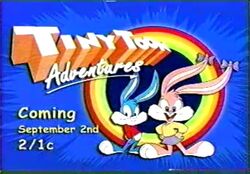
A screenshot from a promo advertising Tiny Toons' second run Nickelodeon
Following its departure from Fox Kids in 1995, Tiny Toon Adventures aired in reruns on Nickelodeon from 1995 to 1999. During this time, the episodes were always book-ended with animated bumpers depicting a group of kids going to a theater to watch the show right before it began, and then cheering after it was finished. Notably, it was on Nickelodeon that they were able to air the Halloween episode "Toons from the Crypt", which Fox had refused to run. However, most online fan-made episode guides were never updated to make note of this.
Tiny Toons eventually left Nickelodeon in September 1999, when its contract to run on the network expired, and the reruns were sent to Cartoon Network from 1999 to 2001. In September 2002, the Tiny Toons reruns returned to Nickelodeon and its sister channel Nicktoons for another two years.
Unlike Animaniacs, which shortened the intro, replaced them coming out of the WB shield with the Nickelodeon logo and changed the variable line to one of their own, and Pinky and the Brain, which was ridden with insertions of the Nickelodeon logo, the show's intro was unedited, but the shot of the WB Shield zooming out at the beginning of the intro sequence was replaced with a fade from black to the Tiny Toons logo.
Pinky and the Brain and Pinky, Elmyra, & the Brain (2000-2005)[]
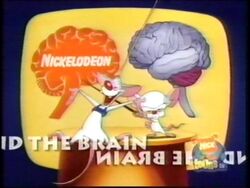
One of the many insertions of Nickelodeon's logo in the Pinky and the Brain theme
Reruns of Pinky and the Brain and its spin-off began airing on Nickelodeon on September 4, 2000, and its TV rights would remain under Nick until 2005.
The episodes themselves were generally unedited, but Nickelodeon literally wrote their name all over the intro sequence by having their logo replace the original colors of a background or foreground object. For example, Brain's mathematical equation during the line "One is a genius, the other's insane", was changed to a drawing of the Nickelodeon logo. Also, at the very end of the intro sequence, a lightning bolt would strike the sign on the Acme Labs building and change it to the Nickelodeon logo. Nick had never done this with any other show they had not created, and this caused quite a bit of controversy with the show's fans.
Animaniacs (2001-2003)[]
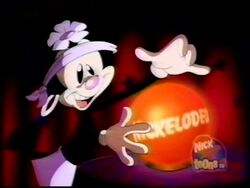
The infamous "Nickelaney" shot from Nick's altered version of the Animaniacs theme
Appropriately following Pinky and the Brain joining the channel, Animaniacs reruns came to Nickelodeon on September 3, 2001, and aired on the channel for the next two years.
But in what proved to be even more controversial than with Pinky and the Brain, was Animaniacs overall has been heavily butchered by the network. Nick not only wrote their name on the intro (the zoom-in to the WB Water Tower at the start was replaced by the logo breaking through a screen with the Nickelodeon logo), but they also shortened down the song and replaced all the variable lines with a custom-made one of their own that did not even rhyme. Additionally, the first half of the lyrics were set to clips that came later in the song and pitched up two semitones to match the final verse. The shortened lyrics to the theme song were as follows:
- It's time for Animaniacs!
- And we're zany to the max! (set to "We have pay-or-play contracts!")
- So just sit back and relax (set to "We're zany to the max")
- You'll laugh till you collapse, (set to "There's baloney in our slacks!")
- We're animany,
- Totally insaney,
- Nickelaney, (set to "Shirley McLainey")
- Animaniacs!
- Those are the facts!
The fans were outraged, so much that some of them refused to watch the show on the channel, on suspicion that Nick was even editing the episodes to change all mentions of Warner Brothers to mentions of Nickelodeon. The episodes were indeed edited on the channel, but instead it was some scenes being cut out for timing purposes (though in some cases, such as "Cutie and the Beast", it would ruin a joke).
Space Jam (2020)[]
On 11 February 2020, Nickelodeon aired the movie Space Jam, making it the first time that anything Looney Tunes-related aired on the network since 2005.[5]
References in Looney Shows[]
- The Tiny Toons Spring Break Special - While traveling home from Fort Lauderdale, the Tiny Toons gang's bus runs over a chicken and a beaver who resemble Ren and Stimpy. Given that Ren & Stimpy creator John Kricfalusi reportedly disliked Tiny Toons, this joke was probably done to get back at his criticism.
- Animaniacs: The "Animani-rats" segment is a parody of the intro sequence to Rugrats.
- Duck Dodgers: In one episode a character resembling SpongeBob SquarePants is a busboy.
References to Warner Bros.-Owned Works[]
- In the first episode of Ren & Stimpy, Muddy Mudskipper chases Stimpy in a Yogi Bear parody and prompts him to say his line. Stimpy responds by spouting other cartoon characters' catchphrases, among them "I'm hunting fow a wabbit!"
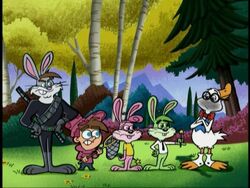
The Looney Tunes parody scene in Channel Chasers
- The Fairly OddParents movie Channel Chasers has a scene where series protagonist Timmy Turner and Cosmo & Wanda, along with an older version of himself from the future, chase Vicky through several parody scenes of other TV shows, including Looney Tunes. In this particular scene, Timmy is dressed like Elmer, his adult self is now a rabbit resembling Bugs, and Cosmo and Wanda have become rabbits resembling Buster and Babs. While searching through the woods, they encounter a white duck who has his beak twisted to the other side of his face, akin to Daffy in "Rabbit Fire". Cosmo asks, "Ehh, what's up, dork?", to which the duck replies by telling them that Vicky went in the same direction they're going in. Additionally, the very last shot of the film has Cosmo attempting to do Porky Pig's "Th-th-th-that's all, folks!" bit, but is stuttering because he's cold.
- In the SpongeBob SquarePants episode "The Bikini Bottom Triangle", one of the mermaids addresses SpongeBob as "Freakazoid".
- In the SpongeBob SquarePants episode "Christmas Who" when Sandy was explaining Christmas to SpongeBob she looked like Road Runner at one point.
- In the SpongeBob SquarePants episode "Patrick SmartPants" Patrick falls of a cliff which looks like Wile E. Coyote falling off a cliff.
Connections[]
|
Stamped on June 2017. This article or section needs additional citations for verification. Please add reliable citations to help verify the article's content.
Do not use Wikipedia or any other wikis as a source. Unsourced info can be questioned and may be removed without notice. Do not remove this template until all conditions have been met. |
- Mel Blanc voiced Bugs Bunny and Daffy Duck on the second Looney Tunes on Nickelodeon intro.
- Bill Melendez voiced Snoopy/Woodstock on You're on Nickelodeon, Charlie Brown.
- Charlie Adler voiced The Bigheads in Rocko's Modern Life and Ickis in Aaahh!!! Real Monsters.
- Carlos Alazraqui voices Denzel Crocker in The Fairly OddParents, Rocko in Rocko's Modern Life and Winslow in CatDog.
- Dee Bradley Baker voices extra characters in The Fairly OddParents and SpongeBob SquarePants.
- Clancy Brown voices Mr. Krabs in SpongeBob SquarePants.
- Jim Cummings voiced Skrawl in ChalkZone, Ultralord in The Adventures of Jimmy Neutron and Cat in CatDog.
- Tim Curry voiced Nigel Thornberry in The Wild Thornberrys and Professor Calamitous in The Adventures of Jimmy Neutron.
- Grey DeLisle voiced Vicky and Tootie in The Fairly OddParents, Sam Manson in Danny Phantom, and Frida Suarez in El Tigre: The Adventures of Manny Rivera.
- Debi Derryberry was the voice of Jimmy Neutron.
- Jessica Di Cicco voiced Gwen Wu in The Mighty B!, Heloise in Jimmy Two-Shoes and Lucy and Lynn from The Loud House.
- David Kaufman voiced the title character of Danny Phantom.
- Tom Kenny voices the title character of SpongeBob SquarePants, Gary the Snail, Dog in CatDog, Heffer in Rocko's Modern Life and Cupid in The Fairly OddParents.
- Maurice LaMarche did additional voices in several American made Nick shows.
- Dan Castellaneta voiced Phil Shortman in Hey Arnold!
- Tress MacNeille voiced Dot Warner in the Nickelodeon intro of Animaniacs and in the reboot, Charlotte Pickles (Angelica's mom) in Rugrats, Gertie Shortman in Hey Arnold! and Spy Fly in ChalkZone.
- Candi Milo voiced Snap in ChalkZone, Tutu in Oh Yeah! Cartoons,[6] and Nora Wakeman in My Life as a Teenage Robot.
- Laraine Newman voiced Queen Jipjorrulac in The Fairly OddParents.
- Rob Paulsen voiced Yakko Warner in the Animaniacs on Nickelodeon intro and the reboot, Mark Chang in The Fairly OddParents, Carl Wheezer in The Adventures of Jimmy Neutron, Peck the Rooster in Barnyard, and one of the seagulls in The SpongeBob Movie: Sponge Out of Water.
- Tara Strong voiced Timmy Turner in The Fairly OddParents, and Dil Pickles in Rugrats.
- Cree Summer voiced Susie Carmichael in Rugrats and All Grown Up!, Tiff Krust in My Life as a Teenage Robot, and Valerie Grey in Danny Phantom.
- Billy West was the original voice of Stimpy, as well as Ren's voice in the later years of Ren & Stimpy. He was also the original voice of Doug. He also voiced Zim in the original pilot for Invader Zim.
- Kath Soucie voiced Phil Lil and Betty DeVille in Rugrats, Miriam Pataki in Hey Arnold!, Maddie Fenton in Danny Phantom, and did additional voices in The SpongeBob SquarePants Movie.
- Neil Ross voiced the Cyclops in The SpongeBob SquarePants Movie.
- Rodger Bumpass voices Squidward in SpongeBob SquarePants and Professor Membrane in Invader Zim.
- Frank Welker voiced the giant clams in SpongeBob SquarePants and the howling of the coyotes in Barnyard.
- June Foray voiced Blocky and Svetlana the Spy (parodies of her Rocky and Natasha characters) in Rugrats.
- Mark Hamill voiced Firelord Ozai in Avatar: The Last Airbender.
Videos[]
Gallery[]
References[]
- ↑ Atlus Times TV Guide (Saturday at 5:30 on ch. 14)
- ↑ Atlus Times TV Guide (Saturday at 12:30 on ch. 31)
- ↑ The Southeast Missourian TV Guide (Saturday at 12:00 and 12:30, next to "(NICK)")
- ↑ https://web.archive.org/web/20120718153130/http://looney.goldenagecartoons.com/tv/nick/
- ↑ https://nickelodeon-premieres.fandom.com/wiki/February_2020_Nick_Premieres#Movies
- ↑ https://www.youtube.com/watch?v=aCYzBzFZvB0
External Links[]





















